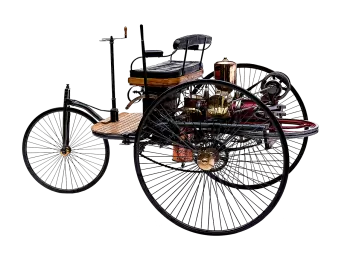
One of the earliest examples of conversion of rotary to reciprocating motion is the crank mechanism. The earliest hand cranks appeared in China during the Han Dynasty (202 BC-220 AD).
Several sawmills in Roman Asia and Byzantine Syria during the 3rd–6th centuries AD used connecting-rod mechanisms to transform the rotary motion of a waterwheel into linear motion that drove saw blades.
Invention of the crankshaft
In 1206, the Arab engineer Al-Jazari perfected this principle by inventing the crankshaft, a key component in modern reciprocating engines. His work on the transmission of motion laid the groundwork for the development of internal combustion engines centuries later.
The crankshaft was invented in ancient times, but its development has gone through several stages.
The first examples of such mechanisms are found in ancient Rome, where the engineer Philo of Byzantium (3rd century BC) described devices that used a system of connecting rods and cranks. However, it was not a complete crankshaft.
Who invented the crankshaft?
The closest design to the modern crankshaft appeared in the 9th century, thanks to the Muslim engineer Al-Jazari (1136-1206). In his book "The Book of Knowledge of Ingenious Mechanical Devices", he illustrated a crankshaft-connecting-rod mechanism, used in one of his hydraulic machines. This was a key step in the evolution of the crankshaft as we know it today.
The development of the modern crankshaft occurred with the Industrial Revolution, especially with the arrival of internal combustion engines in the 19th century. Here, names such as James Watt and Nikolaus Otto were key in its perfection and application in machinery and automobiles.
Evolution of piston engines
Piston engines have played a fundamental role in the history of mechanical power. A free piston engine is a type of internal combustion engine in which the movement of the piston is not controlled by a crankshaft, but by the interaction between the forces of the combustion chamber gases, a rebound device and a charging device.
The power generated in these engines is extracted through exhaust gas pressure to drive a turbine, operate an air compressor or generate electricity through a linear alternator built into the pistons.
The development of piston engines accelerated in Europe during the 18th century, beginning with atmospheric engines and later with James Watt's steam engine. This invention revolutionized industry and transport, facilitating the creation of railways and steamships.
During the 19th century, new innovations emerged such as the Stirling engine and the internal combustion engine, which became the dominant technology in the 20th century. Their application in automobiles, ships and aviation allowed for a great advance in mobility and global trade.
Currently, internal combustion reciprocating engines run on gasoline, diesel, liquefied petroleum gas (LPG) or compressed natural gas (CNG) and are essential for vehicle propulsion and power generation.
First generation of free piston engines
The modern free piston engine was proposed by RP Pescara and was initially used as a single piston air compressor.
Pescara established the Pescara Technical Office for the development of these engines, with Robert Huber as technical director from 1924 to 1962.
Between 1930 and 1960, several first-generation free-piston engines were developed, most notably those of opposed design, in which two pistons were mechanically linked to ensure symmetrical movement.
These motors offered advantages such as lower vibration and greater compactness compared to conventional motors, and were used in industrial and military applications.
Featured alternative engines throughout history
Over time, various reciprocating engines have marked milestones in mechanical engineering.
- Pratt & Whitney R-4360 "Wasp Major" radial engine (World War II): This 3,500 hp (2,600 kW) 28-cylinder engine powered the last generation of large piston-engined aircraft before the widespread adoption of jet and turboprop engines in 1944. With a total capacity of 71.5 L (27.4 gal), it was notable for its high power-to-weight ratio and enabled the construction of more efficient bombers and air transports.
- Wärtsilä-Sulzer RTA96-C diesel engine (2006): Considered one of the largest reciprocating engines in production, this turbocharged engine is used in the largest container ships such as the Emma Mærsk . In its 14-cylinder version, it measures 13.5 m high, 27 m long and weighs over 2,300 metric tons, generating over 84.42 MW (114,800 bhp). Each cylinder has a capacity of 1,820 L, giving a total of 25,480 L for the larger versions. Its efficiency allows for the transport of large cargo volumes with optimized fuel consumption.
Impact and future of alternative engines
Reciprocating engines have been the basis of the industrial revolution and the technological development of land, sea and air transport. Their evolution allowed the expansion of railway networks, the rise of commercial aviation and the globalisation of trade.
Despite the rise of electric and hydrogen technologies, internal combustion engines continue to evolve with improvements in efficiency and reduction of polluting emissions.
Current research is exploring new fuels such as hydrogen, biofuels and synthetic fuels to extend the life of alternative engines within a more sustainable energy model. In addition, the combination of thermal engines with hybrid technologies could allow a gradual transition towards the electrification of transport without losing the advantages of current systems.
The future of alternative engines will depend on their ability to adapt to stricter environmental regulations and on research into lighter and more efficient materials. Their legacy in the history of engineering will continue to be fundamental in the evolution of global mobility.